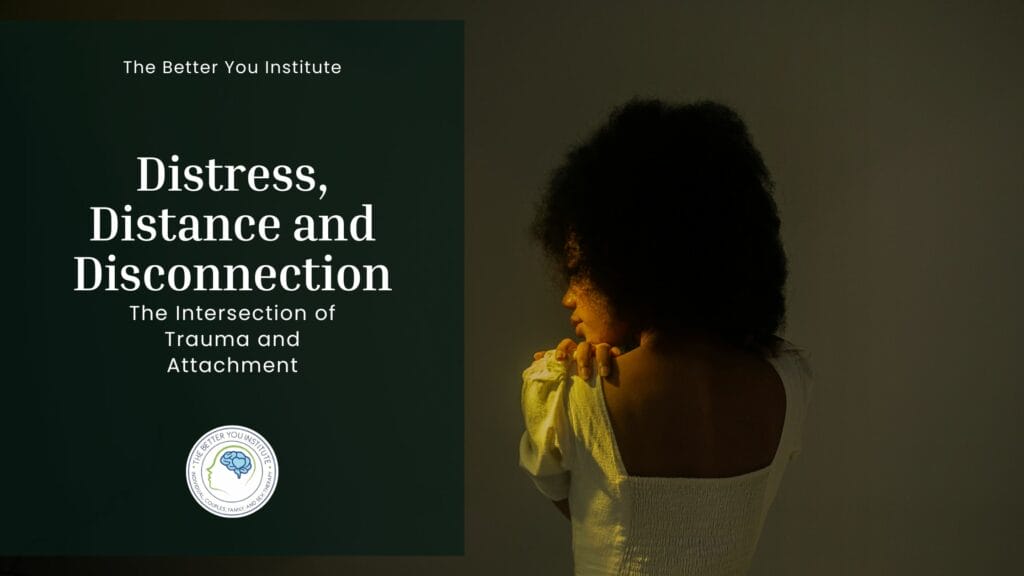Table of Contents
Introduction to Attachment Theory
Attachment theory serves as a foundational framework for understanding the dynamics of relationships, particularly how individuals form emotional bonds and respond to separation and reunion. In this blog, we’ll delve into the core principles of attachment theory and explore its significance in shaping adult relationships.
Exploring the Basics of Attachment Theory and Its Importance in Relationships
Attachment theory, pioneered by John Bowlby, underscores the innate need for humans to seek proximity to caregivers during distress, forming secure emotional bonds. These early experiences profoundly impact later relationship patterns, influencing how individuals approach intimacy and manage emotional closeness with friends, family, lovers, and themselves. Our early childhood attachments are integral to developing our worldview and sense of Self.
Understanding the Core Principles of Attachment Theory
At the heart of attachment theory lies the concept of the attachment cycle, wherein individuals oscillate between seeking proximity to attachment figures for safety and comfort and exploring their environment to learn and grow. This cycle forms the basis for understanding attachment styles and their implications for adult relationships.
The Development of Attachment Styles
Tracing the trajectory of attachment styles from childhood to adulthood reveals the pivotal role of early experiences in shaping attachment patterns. Secure attachments foster feelings of safety and trust, while insecure attachments on a child may lead to relationship difficulties and emotional distress because of distrust, low self-confidence, and emotional dysregulation.
Tracing the Origins of Attachment from Childhood to Adulthood
The journey of attachment begins in infancy, as infants instinctively seek proximity to their primary caregivers for safety, security, and comfort. Through responsive and attuned caregiving, infants develop a sense of trust and security in their relationships, laying the foundation for healthy attachment bonds. As children grow and explore their environment, they continue to rely on their caregivers as a source of safety and support, forming internal working models of attachment that shape their expectations and behaviors in relationships. These early attachment experiences are templates for future interactions, influencing how individuals approach intimacy, navigate conflict, and regulate emotions in adulthood. By tracing the trajectory of attachment from childhood to adulthood, we gain insight into the enduring impact of early relational experiences on adult attachment patterns and the importance of fostering secure attachment bonds for relational well-being.
How Early Experiences Shape Attachment Patterns
Early interactions with caregivers lay the groundwork for attachment development, influencing individuals’ beliefs about themselves and others. Secure attachments stem from consistent caregiving, whereas inconsistent or neglectful care may result in insecure attachment styles.
Example of Secure Attachment Development: A toddler begins to whimper out of frustration they cannot get something opened. The caregiver kneels to their level, is curious with them about the problem – “Are you upset because you can’t get the toy egg opened?”, builds them up, “I have seen you get it opened on your own before. I bet you can do it if you try a few more times.”, and stays with them while they figure it out “I’m right here if it turns out that you do need my help, but I think you got this one!”.
This child will learn to believe in their skills. They will know they can rely on their caregiver to help but won’t feel pressured or fearful. The proximity of the caregiver on their level helps them feel safe in the moment. When a child feels safe, their fight or flight doesn’t go off. They will be able to access their rational brain and use different skills to solve problems, relate to others, or set boundaries.
Example of Insecure Attachment Development: A toddler begins to whimper out of frustration they cannot get something opened. They bring it to the parent who ignores them. They continue to whimper more, now tapping the parent with the toy they can’t get open. The parent makes a comment, “not now!” The toddler then becomes very upset. The caregiver takes the toy from them and says, “if you can’t play with it then don’t play with it.” The todder is now crying. The parent ignores the toddler. The toddler eventually calms down. Later, the parent finds the toy, opens it, and gives it to the toddler saying, “here you go, it wasn’t even that hard to open. Say thank you to mommy/daddy!”
This child will learn that their immediate emotions aren’t big enough for the attention of others. They may even learn not to explore anymore, as it’s not time for that or them, ever. This child may also learn to be a people pleaser putting their needs aside and being thankful to others even when they needed it earlier.
Family Roles and Their Effect on Attachment
Family dynamics play a significant role in shaping attachment styles, with each member assuming distinct roles that contribute to the family system’s functioning. Understanding these roles can illuminate how family dynamics influence attachment patterns and interpersonal relationships.
Understanding Family Roles in Attachment Theory
Family roles are pivotal in shaping attachment dynamics, as each member contributes to the family system in distinct ways that influence attachment development. Parents typically serve as primary attachment figures, providing love, nurturing, and guidance that foster secure attachment bonds. Siblings also play a significant role in shaping attachment patterns, serving as companions, rivals, and sources of support within the family dynamic. Moreover, extended family members, such as grandparents or aunts and uncles, can impact attachment by providing additional caregiving and support. Understanding these family roles helps individuals recognize their own relational patterns and dynamics, offering insight into how early experiences within the family unit shape attachment styles and interpersonal relationships later in life. By exploring family roles through the lens of attachment theory, individuals can better understand their attachment dynamics and work towards fostering healthier and more fulfilling relationships.
How Do I Know What My Role Was In My Family?
Reflecting on one’s family dynamics and identifying personal roles within the family system can provide insight into attachment patterns and relational dynamics. Recognizing these roles is the first step toward fostering healthier relationship dynamics. Common family roles are caregiver, scapegoat, peacemaker, hero, golden child, family clown/comic relief, mediator, or rebel.
Attachment Styles: An Overview
Attachment theory categorizes attachment styles into secure, anxious, avoidant, and disorganized patterns, each characterized by distinct behaviors and relational dynamics. Understanding these styles is crucial for recognizing how individuals approach intimacy and manage emotions in relationships.
Understanding Secure, Anxious, Avoidant, and Disorganized Attachment Styles
Attachment theory categorizes attachment styles into four main patterns: secure, anxious-preoccupied, dismissive-avoidant, and fearful-avoidant (also known as disorganized). Secure attachment is characterized by a healthy balance of independence and intimacy, with individuals feeling comfortable with both closeness and autonomy in relationships. Anxious-preoccupied attachment involves a heightened need for reassurance and fear of abandonment, often leading to clinginess and emotional volatility. Dismissive-avoidant attachment is marked by a reluctance to rely on others and a tendency to prioritize independence over intimacy. Fearful-avoidant attachment combines elements of both anxious and avoidant attachment, resulting in ambivalence towards relationships and difficulty trusting others. Understanding these attachment styles provides insight into individuals’ relational patterns, emotional needs, and coping strategies, guiding efforts toward fostering healthier and more secure attachment bonds.
Recognizing the Characteristics and Behaviors Associated with Each Style
Secure attachment is characterized by a sense of security and trust in relationships, whereas anxious attachment manifests as fear of abandonment and preoccupation with closeness. Avoidant attachment involves a reluctance to rely on others, while disorganized attachment results from unresolved trauma or inconsistent caregiving.
The Impact of Attachment Breaks
Attachment breaks, or disruptions in caregiving relationships, can profoundly affect individuals’ emotional well-being and relational functioning. Exploring the consequences of attachment trauma sheds light on how past wounds influence present interactions and relationship dynamics.
Exploring the Effects of Attachment Trauma and Breaks on Adult Relationships
Attachment trauma and breaks in caregiving relationships during childhood can have profound and lasting effects on adult relationships. Individuals who have experienced attachment trauma may struggle with trust, intimacy, and emotional regulation in their relationships, leading to difficulties in forming and maintaining close connections. These challenges may manifest as patterns of avoidance, anxiety, or ambivalence in adult relationships, impacting both romantic partnerships and friendships. Recognizing and addressing attachment-related wounds is essential for fostering healing and promoting healthier relational dynamics in adulthood.
How Past Attachment Wounds Influence Present Interactions
Unresolved attachment wounds may manifest as difficulties in forming and maintaining healthy relationships, leading to patterns of distress, distance, and disconnection. Understanding the origins of these wounds is essential for fostering healing and promoting healthier relational patterns.
Distress, Distance, and Disconnection: The Intersection of Trauma and Attachment
Trauma can significantly impact attachment development, disrupting individuals’ ability to form secure emotional bonds and regulate emotions in relationships. Exploring the link between trauma and attachment underscores the importance of trauma-informed approaches in therapeutic interventions.
Understanding the Link Between Trauma and Attachment
Trauma can profoundly impact attachment development, disrupting individuals’ ability to form secure emotional bonds and regulate emotions in relationships. Early experiences of neglect, abuse, or loss can create attachment wounds that manifest as difficulties in trusting others, managing emotions, and establishing intimacy. Moreover, unresolved trauma can exacerbate attachment-related challenges, perpetuating cycles of distress and disconnection in relationships. Recognizing the link between trauma and attachment underscores the importance of trauma-informed approaches in therapy, providing a pathway toward healing and relational resilience.
Trauma and Attachment Theory: A Brief Overview
Trauma can disrupt attachment bonds, leading to attachment-related difficulties such as hypervigilance, emotional dysregulation, and challenges in forming trusting relationships. Integrating trauma-informed care into attachment-oriented therapy can facilitate healing and promote resilience in adult relationships.
Attachment Breaks in Childhood
Caregiver relationships play a crucial role in shaping attachment patterns during childhood, with early attachment breaks contributing to long-term emotional and relational challenges. Examining the role of caregivers in attachment development highlights the significance of early relational experiences in shaping adult attachment styles.
Examining the Role of Caregiver Relationships in Attachment Development
Caregiver relationships serve as the foundation for attachment development, shaping individuals’ beliefs about themselves and others. Responsive and consistent caregiving fosters secure attachment bonds, instilling a sense of trust and emotional security in relationships. Conversely, inconsistent or neglectful caregiving can lead to insecure attachment patterns, characterized by anxiety, avoidance, or ambivalence towards intimacy. By examining the quality of caregiver relationships during early development, we gain insight into the roots of attachment patterns and the importance of nurturing and supportive caregiving for healthy attachment development.
Identifying Early Attachment Breaks and Their Long-Term Effects
Early attachment breaks, whether due to neglect, abuse, or loss, can have enduring effects on individuals’ emotional well-being and relational functioning. Recognizing these early wounds is essential for understanding and addressing attachment-related difficulties in adulthood.
The Impact of Childcare on Attachment Styles: Does Daycare, Nanny, or Stay-at-Home Parent Matter?
The type of childcare environment can influence attachment formation, with secure attachments often fostered in nurturing and responsive caregiving settings. Exploring the link between childcare arrangements and attachment styles can inform parents’ and caregivers’ decision-making.
Exploring the Link Between Early Caregiving and Attachment Formation
Early experiences with our caregivers are crucial in shaping attachment formation, laying the groundwork for individuals’ relational patterns and emotional regulation skills—responsive and nurturing caregiving fosters secure attachment, building trust and safety in relationships. Conversely, inconsistent or neglectful caregiving can lead to insecure attachment styles, with difficulties forming trusting and intimate connections. By examining the link between early caregiving and attachment formation, we gain insight into the profound impact of early relational experiences on individuals’ emotional well-being and relational functioning throughout life.
What Childcare Setting Should I Choose?
When considering childcare options, prioritizing environments that promote secure attachment and provide consistent and responsive care can support healthy attachment development in children. Understanding the impact of childcare on attachment can empower parents to make informed choices for their children’s well-being. Each child is different and, therefore, may need different caretaking styles to attune to their needs.
Attachment Breaks in Romantic Relationships
Attachment breaks in romantic relationships can trigger feelings of insecurity, mistrust, and emotional distress, impacting the quality and longevity of partnerships. Addressing attachment insecurities and trust issues is crucial for fostering healthy and fulfilling romantic relationships.
Understanding How Attachment Breaks Manifest in Romantic Partnerships
Attachment breaks in romantic relationships may manifest as patterns of conflict, emotional distance, or difficulty forming intimate connections. Recognizing these patterns can provide insight into underlying attachment dynamics and guide relational healing and growth efforts. Additionally, these patterns may appear in multiple areas of your life, from arguments to sex and points of connection. This is why it is important to explore and understand your patterns so that you can point them out and address them as they become hindrances or helpers in your romantic relationships.
Addressing Attachment Insecurities and Trust Issues in Adult Relationships
Addressing attachment insecurities and trust issues in adult relationships requires a combination of self-awareness, communication skills, and therapeutic support. Individuals can begin by identifying their attachment style and exploring how past experiences may influence their present interactions and behaviors. Cultivating open and honest communication with partners, practicing vulnerability, and seeking professional guidance can facilitate healing and promote greater intimacy and trust in relationships. By addressing attachment-related challenges in relationships proactively, individuals can cultivate healthier relational dynamics and foster deeper connections with their partners.
How Our Attachment Styles Affect Our Sexual Relationships
Attachment styles can influence individuals’ experiences and behaviors in sexual relationships, shaping their approach to intimacy, communication, and sexual satisfaction. Exploring the link between attachment and sexuality can promote awareness and empowerment in navigating sexual dynamics.
Is there a Link Between Attachment and Sexuality
Research suggests that attachment styles impact individuals’ sexual attitudes, preferences, and behaviors, influencing their ability to form secure and satisfying sexual connections. Your attachment styles will guide how you interact with your partners, what you feel comfortable or uncomfortable asking for, and how you approach being sexual with yourself and your partner(s). Understanding the intersection of attachment and sexuality can enhance sexual awareness and promote healthier sexual relationships.
How Can I Get Attachment Awareness for Sexual Empowerment?
Developing attachment awareness can empower individuals to navigate sexual relationships with confidence and agency, fostering greater intimacy, communication, and sexual satisfaction. Incorporating attachment-oriented approaches into sexual therapy can support individuals in addressing relational and sexual concerns. Using appropriate resources like well-researched books and podcasts and seeing a sex therapist can also help.
Attachment Breaks in Friendships and Other Relationships
Attachment breaks can extend beyond romantic partnerships, impacting friendships, work relationships, and other social connections. Exploring how attachment breaks manifest in diverse relationships sheds light on the pervasive influence of attachment dynamics in interpersonal interactions.
Exploring How Attachment Breaks Impact Friendships, Work Relationships, and More
Attachment breaks can have far-reaching effects beyond romantic partnerships, influencing various aspects of individuals’ social and professional lives. In friendships, attachment breaks may lead to feelings of mistrust, insecurity, and difficulty forming close connections. Similarly, in work relationships, attachment wounds can manifest as challenges in collaboration, communication, and conflict resolution. By recognizing the impact of attachment breaks on diverse relationships, individuals can begin to address underlying attachment-related difficulties and work towards building healthier and more fulfilling connections in all areas of life.
Strategies for Healing and Repairing Attachment Wounds in Various Contexts
Healing attachment wounds requires compassion, vulnerability, and a commitment to relational growth. Implementing strategies such as communication skills training, boundary setting, and trauma-informed therapy can support individuals in repairing attachment breaks and fostering healthier relationships.
Here are a few great techniques to repair attachment wounds:
- Participate in active listening with another person where one person focuses on listening and making sure they let the sender of the information feel seen and heard, while the sender of the information speaks from their own experience, using “I” statements
- Allowing the visceral feeling of discomfort and warmth to come over you when someone shows up for you in a different, healthy way that you know is safe but unfamiliar
- Learn the power of ‘no’
- Set boundaries, making sure you are in charge of them. “I will walk away from the conversation if you continue using that tone of voice.”
Attachment-Oriented Therapy Approaches
Attachment-based therapeutic interventions offer a holistic approach to healing attachment wounds and promoting relational resilience. These approaches emphasize the importance of the therapeutic relationship in fostering secure attachment bonds and facilitating emotional growth.
Introducing Attachment-Based Therapeutic Interventions for Healing Attachment Breaks
Attachment-based therapy techniques, such as Emotionally Focused Therapy (EFT) and Attachment-Focused Therapy (AFT), focus on creating a safe and supportive therapeutic environment for exploring attachment dynamics and fostering healing and growth.
Building Secure Attachment Bonds for Healthier Relationships
Through the therapeutic process, individuals can develop greater self-awareness, emotional regulation skills, and secure attachment bonds, laying the foundation for healthier and more fulfilling relationships both within and outside the therapeutic setting.
Healing Attachment Breaks: Strategies for Growth
Navigating attachment trauma requires resilience, self-compassion, and a willingness to engage in the process of healing and growth. Embracing strategies such as mindfulness, self-care practices, and relational skills development can support individuals in overcoming attachment-related challenges and fostering emotional well-being.
Navigating Attachment Trauma and Building Resilience in Adult Relationships
Acknowledging and processing attachment trauma is essential for building resilience and fostering healthier adult relationships. Engaging in therapeutic interventions that address attachment wounds can facilitate healing and promote greater relational satisfaction and intimacy.
Promoting Self-Compassion and Vulnerability in Attachment Healing
Embracing vulnerability and promoting self-compassion are integral aspects of attachment healing, allowing individuals to explore and express their emotions authentically. Embracing these qualities can foster deeper connections with oneself and others, leading to greater emotional well-being and fulfillment.
Healing Through Connection: Understanding Attachment Styles in Your Therapeutic Journey
Understanding one’s attachment style and its impact on the therapeutic process is crucial for fostering meaningful healing and growth. Exploring attachment dynamics within the therapeutic relationship can provide insight into relational patterns and support transformative change.
Understanding Your Attachment Style’s Impact on Therapy
Awareness of one’s attachment style can illuminate how past relational experiences influence present interactions and therapeutic dynamics. Addressing attachment-related challenges within the therapeutic context can promote greater self-understanding and facilitate healing.
Repairing Attachment Wounds in Therapy through the Therapeutic Relationship
The therapeutic relationship serves as a secure base for exploring attachment wounds and fostering relational repair and growth. Engaging in a collaborative and empathic therapeutic process can support individuals in addressing attachment-related difficulties and achieving greater emotional well-being.
Conclusion: Embracing Attachment Awareness for Relationship Transformation
Empowering individuals to recognize and address attachment breaks is essential for fostering healthier and more fulfilling relationships. By promoting attachment security and emotional well-being, we can cultivate greater intimacy, resilience, and satisfaction in adult relationships.
Empowering Individuals to Recognize and Address Attachment Breaks in Their Lives
Encouraging individuals to embrace attachment awareness is the first step towards fostering healing and growth in relationships. By acknowledging and addressing attachment wounds, we can promote greater relational resilience and emotional well-being.
Promoting Attachment Security and Emotional Well-being in Adult Relationships
Prioritizing attachment security and emotional well-being can transform relational dynamics and enhance overall life satisfaction. By fostering self-awareness, compassion, and vulnerability, individuals can cultivate deeper connections and experience greater fulfillment in their adult relationships.







